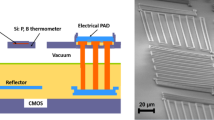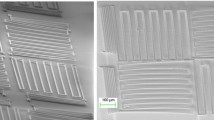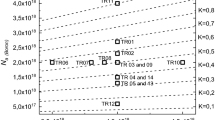Abstract
We describe techniques for testing and characterising semiconductor bolometers, using the bolometer model presented in Sudiwala et. al. [1]. The procedures are illustrated with results from a prototype bolometer for the high frequency instrument (HFI) in the Planck Surveyor cosmic microwave background mission. This is a bolometer using spider-web geometry and a neutron transmutation doped (NTD) germanium thermistor, designed for operation at 100 mK. Details are given of the laboratory facility used to take data at temperatures from 70 mK to 350 mK. This employs an adiabatic demagnetisation refrigerator to cool the detector and optics. The spatial and spectral properties of the optical system are controlled using feedhorns and edge filters. To characterise the bolometer, blanked and optically loaded load curves were measured over a range of temperatures, and the response to modulated radiation was measured as a function of modulation frequency, temperature and bias current. Results for the prototype bolometer show that its behaviour is well represented by an ideal thermal detector down to a temperature of approximately 100 mK. Below this, non-thermal effects such as electron-phonon decoupling or electric field dependent resistance appear to lead to departure from ideal behaviour. The performance was in good agreement with the design goals for the bolometer.
Similar content being viewed by others
References
(Paper I) Sudiwala RV, Griffin MJ, Woodcraft AL. Thermal modelling and characterisation of semiconductor bolometers. Submitted to Int. J. Infrared. Mill. Waves 2002.
Richards PL. Bolometers for infrared and millimeter waves. J. App. Phys. 1994; 76:1.
Griffin MJ. Bolometers for far-infrared and submillimetre astronomy. Nuc. Instrum. Methods. Phys. Res. Sec. A 2000;444:397.
Mauskopf PD, Bock JJ, Castillo HD, et al. Composite infrared bolometers with Si3N4 micromesh absorbers. Applied Optics 1997;36:765.
Haller EE. Advanced far-infrared detectors. Infrared Phys. & Tech. 1994;35:127.
Haller EE, Itoh KM, Beeman JW. Neutron transmutation doped (NTD) germanium thermistors for sub-mm bolometer applications. Proc. 30th ESLAB Symp. “Submillimetre and Far-Infrared Space Instrumentation”, 24–26 September 1996, ESA 1996;SP-388:115.
Mather JC. Bolometer noise: nonequilibrium theory. Applied Optics 1982;21:1125.
Lamarre JM, Ade PAR, Benoit A, et al. The high frequency instrument of Planck: Design and performances. Astro. Lett and Communications 2000;37:161.
Mandolesi N, Villa M. FIRST/Planck mission. In V Piuri, M Savino, editors, ICMT/99. Proceedings of the 16th IEEE Instrumentation and measurement technology conference, IEEE, Piscataway, NJ, USA, volume 2. 1999;975
Bock JJ, DelCastillo HM, Turner AD, et al. Infrared bolometers with silicon nitride micromesh absorbers. Proc. 30th ESLAB Symp. “Submillimetre and Far-Infrared Space Instrumentation”, 24–26 September 1996, ESA SP-388;119.
Duband L, Hui L, Lange A. Thermal isolation of large loads at low temperature using Kevlar rope. Cryogenics 1993;33:643.
Lee C, Ade PAR, Haynes CV. Self supporting filters for compact focal plane designs. Proc. 30th ESLAB Symp. “Submillimetre and Far-Infrared Space Instrumentation”, 24-26 September 1996, ESA SP-388 1996;81.
Maffei B, Ade PAR, Tucker CE, et al. Shaped corrugated horns for cosmic microwave background anisotropy measurements. Int. J. Infrared. Mill. Waves 2000;21:2023.
Woodcraft AL, Sudiwala RV, Wakui E. Measurement of anomalous resistance-temperature relation for neutron transmutation doped germanium. In Proceedings of Low Temperature Detectors 9 (to appear). AIP 2002.
Soudée J, Broszkiewicz D, Giraud-Héraud Y, et al. Hot electrons effect in a #23 NTD Ge sample. J. Low Temp. Phys. 1998;110:1013.
Grannan SM, Richards PL, Hase MK. Numerical optimization of bolometric infrared detectors including optical loading, amplifier noise, and electrical nonlinearities. Int. J. Infrared. Mill. Waves 1997;18:319.
Hanany S. Private communication; measurements were done with A. T. Lee, B. Rabii, P. L. Richards and C. D. Winant of the MAXIMA team.
Pobell F. Matter and Methods at Low Temperatures. Springer, 1992.
Wang N, Wellstood FC, Saduolet B, et al. Electrical and thermal properties of neutron-transmutation-doped Ge at 20mK. Phys. Rev. B 1990;41:3761.
Zhang J, Cui W, Juda M, et al. Non-ohmic effects in hopping conduction in doped silicon and germanium between 0.05 and 1 K. Phys. Rev. B 1998;57:4472.
Wakui E, et al. In preparation, 2002.
Author information
Authors and Affiliations
Rights and permissions
About this article
Cite this article
Woodcraft, A.L., Sudiwala, R.V., Griffin, M.J. et al. High Precision Characterisation of Semiconductor Bolometers. International Journal of Infrared and Millimeter Waves 23, 575–595 (2002). https://doi.org/10.1023/A:1015757810970
Issue Date:
DOI: https://doi.org/10.1023/A:1015757810970




